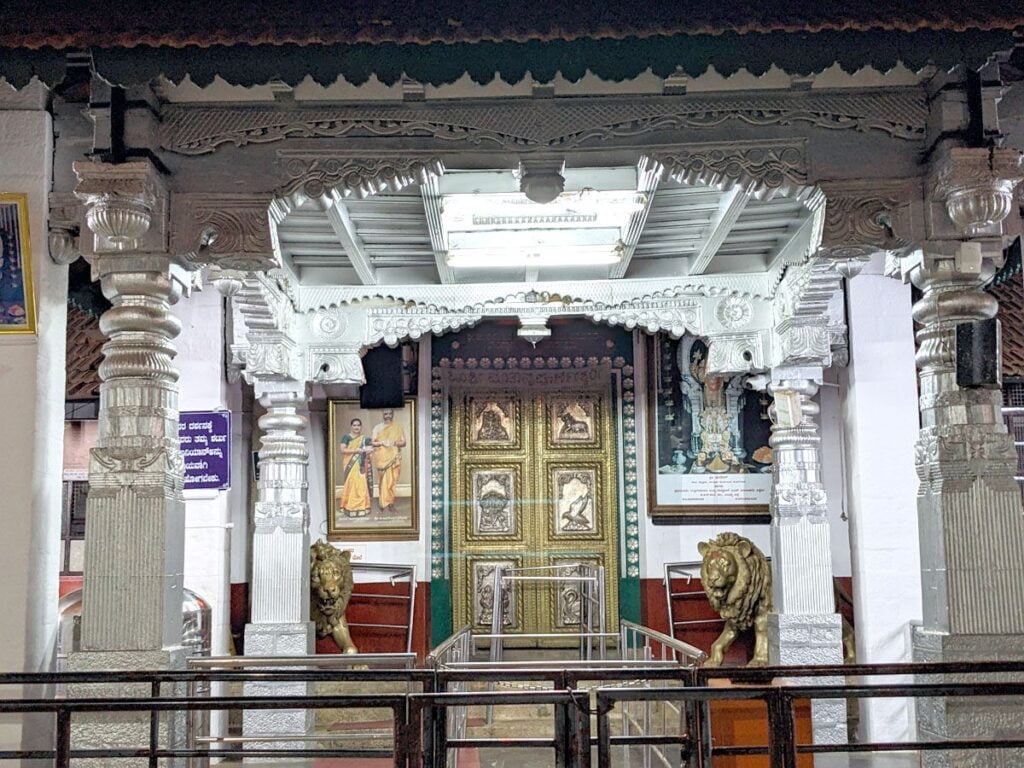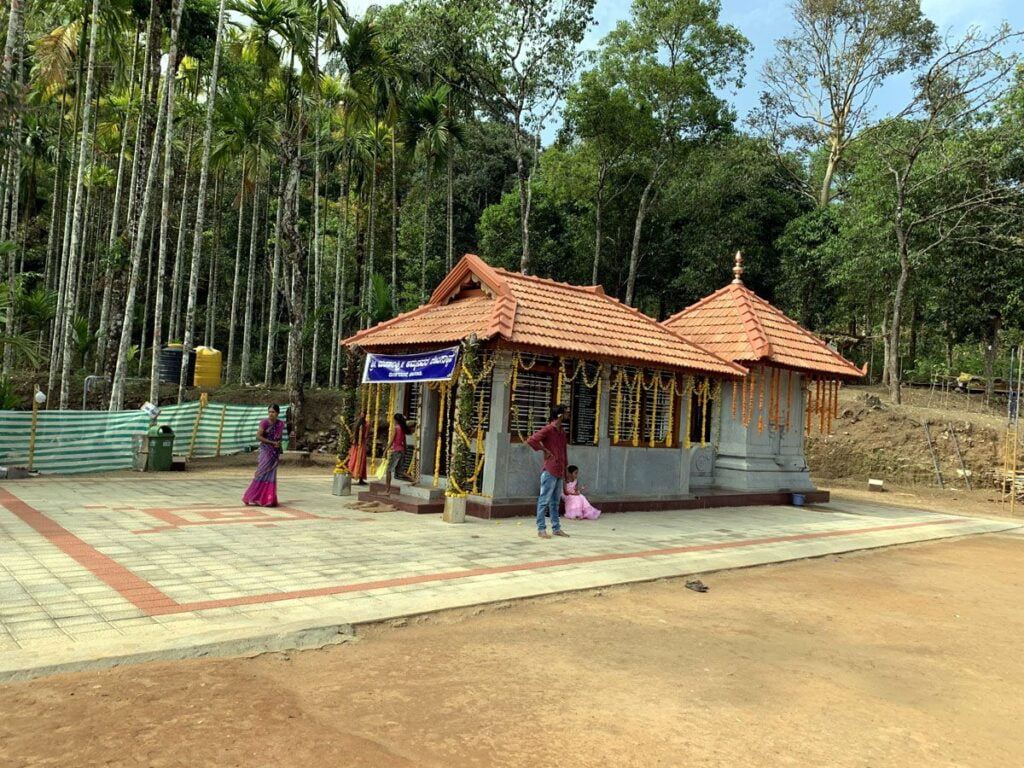Horanadu Annapoorneshwari Temple
The Horanadu Annapoorneshwari Temple is a Hindu temple dedicated to the goddess Annapoorneshwari, located at Horanadu, Karnataka, India, 100 km from Chikmagalur in the thick forests and valleys of the Western Ghats of Karnataka. It is situated on the banks of river Bhadra.

Contents
- 1 Horanadu Annapoorneshwari Temple History:
- 2 Legend of Horanadu Annapoorneshwari Temple:
- 3 Significance of Horanadu Annapoorneshwari Temple:
- 4 Interesting myths and beliefs of Horanadu Annapoorneshwari Temple:
- 5 Horanadu Annapoorneshwari Temple Timing and Rituals:
- 6 Places to visit near Horanadu Annapoorneshwari Temple:
- 7 FAQ:
- 8 How to reach Horanadu Annapoorneshwari Temple:
- 9 Google Maps:
Horanadu Annapoorneshwari Temple History:
The history of the Horanadu Annapoorneshwari Temple is not entirely clear, but it is believed that the temple was built in the 8th century by the sage Agastya. The temple was later renovated and expanded by the Vijayanagara Empire in the 16th century.
The temple is dedicated to the goddess Annapoorneshwari, who is one of the many forms of the Hindu goddess Parvati. Annapoorneshwari is the goddess of food and nourishment, and is often depicted holding a bowl of rice and a ladle.
The temple complex is large and consists of several shrines, including the main shrine to Annapoorneshwari. The main shrine is located in the center of the complex and is surrounded by a number of smaller shrines. The temple also has a large mandapa (hall) where pilgrims can gather.
Read More>> Nimishamba Temple Srirangapatna Mysore
Legend of Horanadu Annapoorneshwari Temple:
- The legend of the curse: According to legend, Lord Shiva was once cursed by a sage. The curse caused him to become hungry and thirsty. Shiva traveled to many places in search of food and water, but he could not find anything to satisfy his hunger and thirst. Finally, he came to the Horanadu Annapoorneshwari Temple. The goddess Annapoorneshwari appeared before Shiva and offered him food and water. Shiva was so grateful that he blessed the goddess and promised to always protect her temple.
- The legend of the golden pot: According to legend, the goddess Annapoorneshwari once appeared before a poor farmer. The farmer was so poor that he did not have enough food to feed his family. The goddess Annapoorneshwari gave the farmer a golden pot that was filled with food. The farmer was so grateful that he used the food to feed his family and his neighbors.
- The legend of the flood: According to legend, there was once a great flood that threatened to destroy the Horanadu Annapoorneshwari Temple. The goddess Annapoorneshwari appeared before the people and promised to protect the temple. She raised her hand and the floodwaters stopped. The temple was saved and the people were grateful to the goddess.
Read More>> Sri Banashankari Temple Bengaluru

Significance of Horanadu Annapoorneshwari Temple:
1. Devotion to Goddess Annapoorneshwari: The temple is dedicated to Goddess Annapoorneshwari, also known as Annapurna, the goddess of food and nourishment. Devotees believe that seeking her blessings ensures they will never face hunger and always have food security.
2. Historical Importance: The temple is believed to have been established by the sage Agasthya several centuries ago. While the main deity was installed in 1973, the temple’s history adds to its spiritual significance.
3. The Golden Statue: The main attraction of the temple is the captivating golden statue of Goddess Annapoorneshwari. This unique feature draws visitors from various regions.
4. Universal Practice of “Annadanam”: The temple is renowned for its practice of “Annadanam”, offering free, three-course meals to all visitors irrespective of their religion, caste, or creed. This practice embodies the spirit of universal compassion and the importance of sharing food.
5. Spiritual Atmosphere and Location: Nestled amidst the picturesque landscape of the Western Ghats, the temple’s setting creates a serene and peaceful atmosphere conducive to spiritual introspection.
6. Association with Lord Shiva: According to legend, the temple is associated with a story where Lord Shiva and Goddess Parvati (Annapoorna) reconciled, highlighting the importance of food and sustenance in life.
7. Vibrant Festivals: The temple celebrates various festivals throughout the year, most notably Akshaya Tritiya, believed to be the birth date of the goddess, and the 5-day chariot festival known as Rathotsava.
Read More>> Hasanamba Temple: Stone Sleeps & Spirit Awakes

Interesting myths and beliefs of Horanadu Annapoorneshwari Temple:
1. The origin of Devi Annapoorneshwari:
This myth involves Lord Shiva and Goddess Parvati. It’s believed that they had a disagreement about the nature of the world. Lord Shiva claimed everything, including food, was an illusion (Maya). To counter his statement and demonstrate the importance of food, Goddess Parvati disappeared. With her absence, nature became stagnant – no weather changes, no plant growth, leading to a global drought. Witnessing the suffering, Goddess Parvati reappeared and distributed food to everyone, restoring balance. This act earned her the name Devi Annapoorneshwari, the goddess of nourishment and sustenance.
2. Lord Shiva’s curse and the overflowing skull:
Another myth tells the story of Lord Shiva being cursed. In this tale, Lord Shiva beheaded Lord Brahma. However, Brahma’s skull got stuck in Shiva’s hand, and a curse plagued him – the skull would only detach once filled with food. He sought help everywhere but found no solution. Finally, he reached the Horanadu temple, where Devi Annapoorneshwari filled the skull with overflowing grains, freeing him from the curse. This story emphasizes the temple’s association with abundance and its ability to fulfill wishes related to food security.
Read More>> Shivoham Shiva Temple: 65 Foot Tall Statue of Lord Shiva

Horanadu Annapoorneshwari Temple Timing and Rituals:
Temple Timings:
The temple is open from 6:30 AM to 9:00 AM, 11:00 AM to 2:00 PM, and 7:00 PM to 9:30 PM.
Rituals:
The following are some of the rituals that are performed at the Horanadu Annapoorneshwari Temple:
- Abhisheka: This is a ritual bath that is performed on the idol of the goddess. It is believed that this ritual cleanses the idol and removes any negative energy.
- Alankar: This is the ritual of decorating the idol of the goddess. The idol is decorated with flowers, jewelry, and other ornaments.
- Aarti: This is a ritual of waving lamps in front of the idol of the goddess. It is believed that this ritual pleases the goddess and brings her blessings.
- Prasad: This is the ritual of offering food to the goddess. The food is then distributed to the devotees as a blessing.
Festivals:
The following are some of the festivals that are celebrated at the Horanadu Annapoorneshwari Temple:
- Navaratri: This is a nine-day festival that is celebrated in the month of September-October. During this festival, the nine forms of the goddess Durga are worshipped.
- Akshaya Tritiya: This is a festival that is celebrated in the month of April-May. It is believed that this is the day on which the goddess Annapoorneshwari was born.
- Varamahalakshmi Vrata: This is a festival that is celebrated in the month of August-September. This festival is dedicated to the goddess Lakshmi, who is considered to be the goddess of wealth and prosperity.
Read More>> 7th Century Virupaksha Temple Hampi

Places to visit near Horanadu Annapoorneshwari Temple:
- Kalasa: Kalasa is a picturesque town near Horanadu, known for its scenic beauty and the Bhadra River. It is also a significant pilgrimage site with the Kalaseshwara Temple.
- Sringeri: Located around 75 kilometers from Horanadu, Sringeri is famous for the Sharadamba Temple and the Vidyashankara Temple. The town is set against the backdrop of the Western Ghats and is known for its cultural and historical significance.
- Kudremukh National Park: If you enjoy nature and trekking, Kudremukh National Park is a great place to visit. It is about 70 kilometers from Horanadu and offers lush green landscapes, trekking trails, and diverse wildlife.
- Kukke Subramanya Temple: Situated around 90 kilometers from Horanadu, this temple is dedicated to Lord Subramanya. It is a popular pilgrimage site and is surrounded by the beautiful Western Ghats.
- Dharmasthala: While a bit farther away (approximately 150 kilometers), Dharmasthala is a significant religious destination with the famous Manjunatha Temple. The town is known for its religious harmony and cultural heritage.
- Bhadra Wildlife Sanctuary: Located about 90 kilometers from Horanadu, this sanctuary is home to diverse flora and fauna. It’s a great place for nature lovers and wildlife enthusiasts.
- Agumbe: Known as the “Cherrapunji of the South,” Agumbe is around 100 kilometers away. It is famous for its rainforests, waterfalls, and stunning sunset views. The sunset point at Agumbe is particularly popular.
- Kemmanagundi: About 120 kilometers from Horanadu, Kemmanagundi is a hill station with beautiful gardens, scenic landscapes, and pleasant weather. The Raj Bhavan, Z Point, and Hebbe Falls are some of the attractions here.
Read More>> Kotilingeshwara Temple Karnataka: 108 Ft Massive Lingam in the world
FAQ:
1. What is the significance of the Horanadu Annapoorneshwari Temple?
The Annapoorneshwari Temple, located in Horanadu, Karnataka, is dedicated to the Hindu goddess Annapoorneshwari, also known as Annapurna. She is the goddess of food and nourishment, and the temple is considered one of the most important pilgrimage sites for Hindus seeking blessings for prosperity and freedom from hunger.
2. What is the history of the temple?
The temple’s exact origins are unknown, but legend attributes its establishment to the sage Agastya. There is also a belief that Adi Shankaracharya, the 8th-century scholar and philosopher, installed the idol of the goddess.
3. What are the timings for darshan (seeing the deity)?
The temple is open for darshan from:
- 6:30 AM to 9:00 AM
- 11:00 AM to 2:00 PM
- 7:00 PM to 9:30 PM
4. Are there any special pujas (prayers) performed at the temple?
The Maha Mangala Aarti, a special prayer ceremony, is performed three times daily:
- 9:00 AM
- 1:30 PM
- 8:30 PM
5. Does the temple offer any food (prasadam) to devotees?
The temple is renowned for its Annadana (food donation) program. Every visitor, irrespective of their religion, caste, or creed, is served a free three-course vegetarian meal, including a dessert. They encourage devotees to take only what they can consume to avoid food wastage.
6. What is the dress code for visiting the temple?
Men are expected to remove their shirts and banians (vests) before entering the temple and preferably cover their shoulders with a dhoti (traditional Indian garment) or towel. Women can wear sarees, salwar kameez, or any other clothing that covers their shoulders and knees.
7. How to reach the Horanadu Annapoorneshwari Temple?
The temple is located around 100 km from Chikmagalur, Karnataka. You can reach Horanadu by:
- Road: Several buses and taxis ply regularly to Horanadu from Chikmagalur and other nearby towns.
- Train: The nearest railway station is Chikkamagaluru, from where you can hire a taxi or take a bus to reach the temple.
- Air: The nearest airport is Mangalore International Airport, which is about 160 km from Horanadu. From there, you can take a taxi or bus to reach the temple.
How to reach Horanadu Annapoorneshwari Temple:
- By Air:
- The nearest airport to Horanadu is Mangalore International Airport (IXE), which is approximately 125 kilometers away.
- After arriving at the airport, you can hire a taxi or use other local transportation to reach Horanadu.
- By Train:
- The nearest railway station is in Mangalore (MAQ), approximately 133 kilometers away.
- From Mangalore, you can hire a taxi or use a combination of buses to reach Horanadu.
- By Road:
- Horanadu is well-connected by road. You can use state-run buses or hire a taxi/private vehicle from nearby cities like Mangalore, Udupi, or Chikmagalur.
- If you are driving, you can use GPS navigation to reach Horanadu. The temple is well-marked on most maps.
